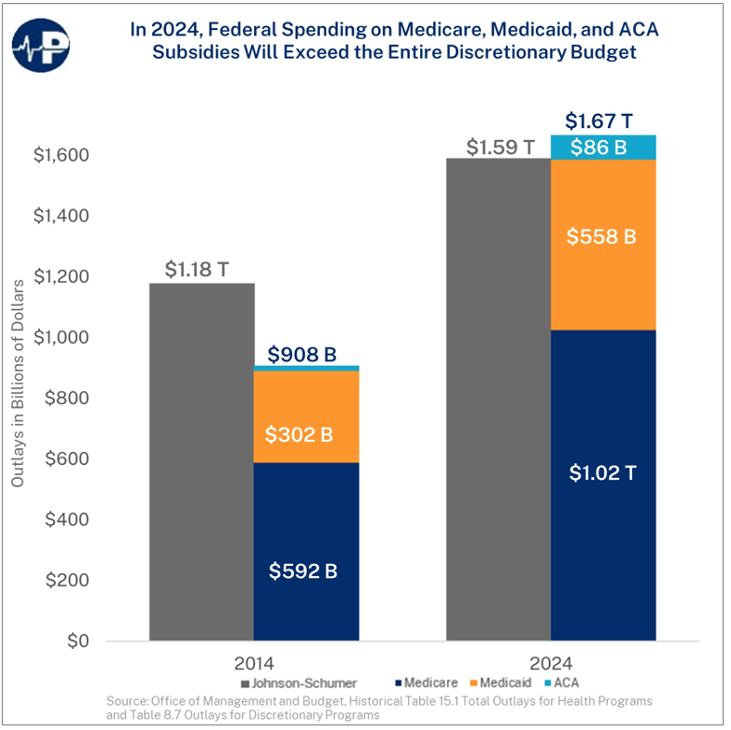Government’s Mandatory Health Care Spending Now Exceeds Entire Discretionary Budget
This week, Drew Gonoshorowski and Theo Merkel of Paragon Health Institute sounded the alarm on how mandatory spending on major federal health care programs now exceeds the entire discretionary budget, driving up our $34 trillion in national debt and crowding out important national priorities, like national security.
Discretionary funding now makes up just 27% of the federal budget, while spending on mandatory programs, including the major health programs, continues on autopilot.
In 2024, federal spending on mandatory health programs – including Medicare, Medicaid, and Obamacare subsidies – is forecasted to reach $1.67 trillion. By 2033 federal spending on these health programs is projected to skyrocket to $3.103 trillion.
By consuming a growing share of the federal budget, mandatory health care spending is the key driver of our nation’s $34 trillion debt, driving America to the edge of insolvency. In fact, while other areas of federal spending are projected to decline in relation to GDP, spending on mandatory health programs is projected to rise, alongside spending on interest on the debt and Social Security, eating up more and more taxpayer dollars and wasting essential resources.
In addition to costing taxpayers trillions each year, mandatory health programs are also failing patients with high costs and significant barriers to accessing high-value health care. American taxpayers and patients deserve a competitive and efficient health care system that delivers low-cost, high-value health care without busting the federal budget.
Word on the Street via Paragon Health Institute:

- “While the discretionary budget dominates Congressional attention, the federal government is projected to spend more in 2024 on just three health care programs – Medicare, Medicaid, and Affordable Care Act (ACA) subsidies for insurance companies.”
- “The discretionary budget funds many government agencies and programs. In theory, the annual process gives lawmakers the opportunity to annually scrutinize these programs and weigh their value against others demanding taxpayer resources.”
- “Our largest health care programs are largely shielded from this annual process. Medicare, Medicaid, and ACA subsidies for insurance companies are mandatory programs that continue to be funded regardless of any new Congressional action.”
- “In 2024, federal spending on these three programs is projected to be $1.67 trillion – more than the entire discretionary budget. Medicare alone is projected to spend more than $1 trillion in taxpayer dollars, larger than the entire defense budget.”
- “Absent reform, the growth of our mandatory health programs, and the interest on the debt to finance them, will continue to grow at a pace that continues to crowd out spending on other federal priorities. Consider that just 10 years ago these programs totaled were 23 percent less than the entire discretionary budget.”
- “At some point Congress will need to focus on where the money is. To avoid severe economic pain and a decline in American standard of living, policymakers must get serious about confronting the rising red ink from government health care programs.”
The Bottom Line:
Reversing the curse of our runaway national debt and restoring fiscal sanity in Washington is not possible without addressing our runaway mandatory health care spending. Policymakers have a responsibility to advance reforms to reduce federal health care spending and improve patient access to quality and affordable health care.
The House Budget Committee’s Fiscal Year 2024 “Reverse the Curse” Budget Resolution included reforms to rein in runaway mandatory spending by putting federal health programs on a sustainable trajectory, while decreasing patient out-of-pocket costs and increasing access to quality care.


